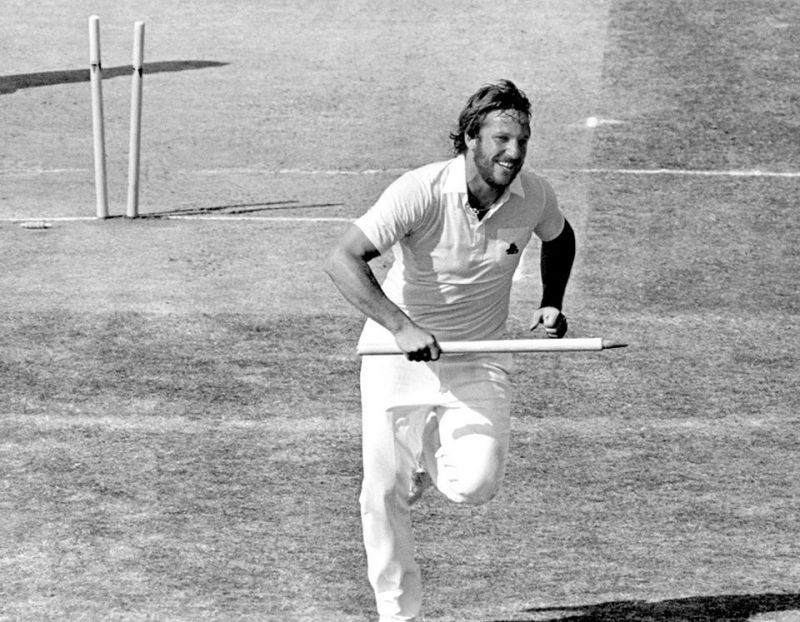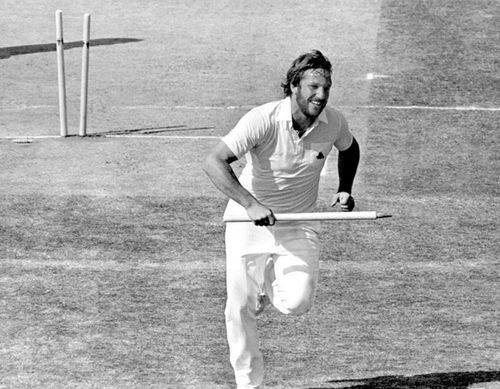
SK Flashback: 38 years ago, an Ashes classic at Edgbaston

The wedding of Princes Charles and Lady Diana Spencer took place on 29th July, 1981 at St Paul’s Cathedral in London. An Ashes Test match was starting on the next day at Edgbaston and it looked like the wedding party had directly descended from there for the reception.
It was one of the noisiest Test matches ever in England, with Union Jacks flying all over the place and lot of patriotic fervor in the air. The sound would reach to a crescendo during the concluding moments of the Test match, and who would have believed that after the miracles of Headingly, there would be another humdinger in store?
The start of the test match was not a great one though. On a seemingly perfect batting pitch (during previous day press conference, Kim Hughes, the Australian captain, had mentioned that 800 runs could be scored there), England won the toss and decided to bat first.
They had to make one forced change from the Headingly match. Graham Dilley was injured and John Emburey replaced him. There was a change in the batting line-up as well. Graham Gooch was pushed down the order and Mike Brearley opened with Boycott, with a somewhat reluctant David Gower at number three.
Day 1: Disappointment for England, Brilliance from Terry Alderman
Australia dropped Trevor Chappell and Martin Kent, from Queensland, replaced him. Geoff Lawson did not recover from injury from the previous match and Rodney Hogg came in his place. England started well, putting up 29 runs in the opening partnership, without much of a problem.
Terry Alderman changed the scenario. He stuck to a beautiful line for 23 overs on the first day and took 5 for 42 to skittle out England for just 189. Only Mike Brearley (48) could do anything decent and that total on that wicket was quite a disappointing batting performance. Chris Old restored some parity at the end of the day for England, picking up two Australian wickets quickly. Australia finished on 19 for 2.
Day 2: Grim battle for the 1st innings lead
The next day’s cricket was hard and combative. Both the teams, knowing that the first innings lead would be vital, gave all they had. Bob Willis bowled a lot of bouncers (along with plenty of no balls) and got into a verbal spat with Kim Hughes. Hughes, playing without a helmet, his collar up and shirt unbuttoned to midriff, was not the one to buckle down under short pitch bowling.
But, strangely, when Graham Yallop came to bat and Willis was expected to send some more short stuff, Hughes tried to protect him by refusing singles. It would not have done too much good to Yallop’s spirit.
For England, Emburey bowled beautifully to take 4 for 43. But, contributions from Hughes (47), Kent (46) and Yallop (30) earned Australia a vital lead of 69. It could have been much bigger without Emburey’s effort. England wiped out 49 of the deficit by the end of second day, after losing Brearley early in the innings.
Day 3: Can lightning strike twice?
Next day, England did not bat better than their effort from the first innings and Ray Bright bowled brilliantly for Australia. When Ian Botham came to the crease, the score was already 110 for 5. Soon, he chased a wide one from Lillee and Marsh took the catch. Australia heaved a sigh of relief.
Their Headingly nemesis was out of picture and England were effectively 46 for 6. Mike Brearley made a strange move then. He promoted Chris Old to have a go at the bowling. Along with Mike Gatting, Old made run-a-ball 23. Suddenly, there was a change in momentum. Alderman was brought back into the attack and he took care of Old soon, leaving England 154 for 7. Not much later, Gatting was bowled by Bright. England were on 167 for 8, a lead of just 98.
The xext 1 hour and 10 minutes would be most frustrating for the Australians. John Emburey and Bob Taylor would somehow conjure a 50-run partnership with not so orthodox, but very effective batting techniques. Emburey was the unsung hero for England in this match. Everyone remembered Botham and his heroics.
But this innings of 37 not out from him and partnership with Bob Taylor were worth of gold. Australians were anxious now. They had again a tricky small chase, with 151 to win.
Australia lost Wood early in the chase and finished the day on 9 for 1. But, they still went to fourth day being huge favorites. This was not an up and down pitch like Headingly. Someone wrote in the newspaper “Lightning does not strike twice”.
Day 4: “I am going to bring Gorilla from the City end”

On the next day morning, Bob Willis bowled another fast and furious spell. He removed John Dyson first and then started his battle with Kim Hughes again. Hughes wanted to take his short pitch balls head-on and hooked a bouncer. While commentating for BBC, Mike Smith got it wrong: “A beautiful stroke from Hughes… Oh, My God, it has flown directly to the only fielder stationed there… A beautiful looking stroke”.
Australia were now 29 for 3 and it looked like Willis was doing it again. He almost got Yallop out in the very next ball and then had Border edging, only to be dropped by the keeper.
Border and Yallop then steadied the innings, and put up a 50-run partnership. Emburey had Yallop caught at silly point soon after that saw Australia in trouble at 87 for 4. However, Kent and Border took the score to 105. Australia needed 46 more runs with six wickets in hand.
Mike Brearley, the England Captain, soon contemplated bringing on the spinners from both ends. He was having a chat with umpire Dickie Bird at square leg. This is how Dickie Bird recollected the conversation in his autobiography-
“What do you think, Dickie” Brearley enquired.
“You have had it, Skipper. No chance” Dicky responded.
“Oh! Dickie, what we should do now?”
“Get yourself on. Finish the match quickly – so that all of us can all hit the Motorways early and go home”.
Brearley responded “That’s not a bad idea”.
In the meantime, one of Emburey’s deliveries suddenly jumped from good length and Allan Border was caught at forward short leg. But, there were two boundaries in the same over and at the end of the over, the score read 114 for 5. Brearley thought that instead of Willey, he needed someone to stem the flow of runs from the other end. He turned to the umpire and said “Change in plan, Dickie. I am going to bring Gorilla from the City end”.
The Gorilla, Ian Botham, was not very keen to bowl. He wrote in his Autobiography: “There was nothing in the pitch for me and I thought Peter Willey was the best option we had”. Bob Taylor would later recollect how Brearley would almost force Botham to wear the bowling shoes in the break and not the tennis shoes he was planning to wear.
Botham's job was to bowl straight and not to give runs. But, it turned out that his next 28 balls would be part of cricket folklore.
In his very first over, Rod Marsh had a wild, across the line heave and lost his middle stump (114 for 6). The xext ball kept low and caught Ray Bright right in front (114 for 7). Lillee was almost out in the hat-trick ball but few minutes later, he had a slash to a ball wide outside the off and Taylor grabbed it in the second attempt (120 for 8).
Botham later would say that he wanted to bowl an inswinger. But, the ball went other way. Probably, he was reverse swinging the ball without really knowing the reason behind it.
Noise in the ground now reached unprecedented level. Botham was running in like a gladiator. Martin Kent went to flick an incoming ball and was bowled (121 for 9). Terry Alderman was the last man. He survived two balls somehow.
But, the inevitable happened on the third. Botham bowled another fast yorker and Alderman’s stump was flattened. Botham let out a war cry, grabbed a stump and ran towards the pavilion, just beating a sea of people who invaded the ground. Botham’s spell read 5/1, in 28 balls and was rightly named as the man of the match.
Aftermath
Although this has been one of the most famous spells in the history of cricket, Botham himself did not rate it very highly: “Yes, I ran in fast and bowled straight. But I think the Australians panicked and threw away their wickets under pressure”.
It was not far from true. Not a word was spoken in the Australian dressing room after the defeat. People could understand Headingly. Now, there was no reason to be given. As per Allan Border, the feeling was “gut-wrenching”.
Rod Marsh was sitting in the dressing room, unable to speak and was sobbing. Even years later, he would say that he would feel pained to talk about the Test. “I should have won the match for Australia and could not. There is no way I can explain the shot I played that day” he would go on to say.
In a series where they should have been leading 3-0, Australia were surprisingly behind 1-2 after this Test. They still had two test matches in hand in that Ashes season. However, two consecutive narrow losses took a lot out of them.
Also read – Ashes Highest Totals
Follow Sportskeeda for all the updates on Ashes live score, news, results, Ashes Schedule, most runs, most wickets and fantasy tips.